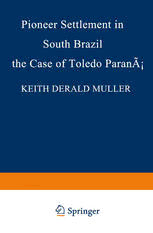
Pioneer Settlement in South Brazil: The Case of Toledo, Paraná PDF
Preview Pioneer Settlement in South Brazil: The Case of Toledo, Paraná
PIONEER SETTLEMENT IN SOUTH BRAZIL: THE CASE OF TOLEDO, PARANA PUBLICATIONS OF THE RESEARCH GROUP FOR EUROPEAN MIGRATION PROBLEMS XIX Editor: Dr. C. Beyer, 17 Pauwenlaan The Hague, Netherlands PIONEER SETTLEMENT IN SOUTH BRAZI L: THE CASE OF TOLEDO, PARANA by KEITH DERALD MULLER I I © 1974 by Martinus Nijhoff. The Hague. Netherlands All i'tghts reserved. including the right to translate or to reproduce this book or parts thereof in any form ISBN-13: 978-90-247-1691-3 e-ISBN-13: 978-94-011-6796-3 DOl: 10.1007/978-94-011-6796-3 TABLE OF CONTENTS LIST OF TABLES VII LIST OF FIGURES VII FOREWORD IX PREFACE XI Chapter I: INTRODUCTION 1 Pioneer Settlement in Brazil 1 The Focus of the Investigation 3 Population Increases in Parana 5 Migration into West Parana 5 Introduction of the Long-lot 6 The Founding of Toledo 7 The Position of Toledo 9 Chapter II: SETTLERS AND THEIR FARMS 13 Choice of Settlers 13 Individual Isolated Farm Type: Italian Examples 17 Individual Isolated Farm Type: A German Example 20 Individual Isolated Farm Type: Japanese Examples 21 Group Settlement Farm Type: A German Immigrant Example 24 Conclusion 26 Chapter III: SETTLEMENT FORM AND STRUCTURE IN TOLEDO 29 Unplanned Settlement 29 VI TABLE OF CONTENTS Planned Settlement 31 Comparison of Square and Long-lot Settlement Forms 34 The Case of Toledo 36 Conclusion 40 Chapter IV: SETTLEMENT SIZE IN TOLEDO: I 42 Data Gathering 42 Sampling 43 The Classification 43 Trends of Ownership Patterns 43 Stages of Settlement 45 Conclusion 48 Chapter V: SETTLEMENT SIZE IN TOLEDO: II 50 Alternatives 50 Objectives 52 Problems Related to Small Farm Size 53 Problems Related to Large Farm Size 54 Steps to Establish the Medium-sized Farm 55 Conclusion 57 Chapter VI: SETTLEMENT FUNCTION: ECONOMIC LIFE IN TOLEDO 60 Agricultural Equipment 60 Agricultural Economy: Commercial Hogs 61 Agricultural Processing Industries 63 Field Systems: South Brazil 65 Field Systems: Toledo 66 Agricultural Assistance 67 Cooperatives 68 Conclusion 69 Chapter VII: CONCLUSIONS 71 Position of the Colonization Project 71 Selection of Settlers 71 Land Titling 72 Settlement Morphology 72 Settlement Size 73 Settlement Function: Vertical Integration and Regional Settlement Development 73 LIST OF TABLES p. 1. Population -- Parana, 1940 -1970 5 2. Precipitation - Porto Mendes, Municipio of Toledo 9 3. Origin of Settlers in Municipios Near Toledo 16 4. Relatedness Among Owners, Toledo 17 5. Sample Farms in Toledo 19 6. Comparison of Square and Long-lot Systems, Random Area of Toledo 35 7. Settlement Types, Maripa Land Company 40 8. Comparison of Initial and Present Holdings, Perimeter 1 44 9. Comparison of Initial and Present Holdings, Perimeter 30 45 10. Number and Percent of Holdings, by Ownership Classes, Toledo 46 11. Percent of Area and Holdings, by Ownership Classes, Groups A and B 47 12. Sources and the Division of Total Farm Labor Force 62 13. Number of Hogs Slaughtered, Sadia - Toledo 64 LIST OF FIGURES p. 1. Pioneer Zones of Brazil 2 2. Migration Currents into West Parana 4 3. Settlement Types, Maripa Land Company - Toledo 8 FOREWORD In the period since the end of world War II numerous develop ing countries have employed colonization, or planned pioneer settlement, as one method of building a more reliable and bal anced economy. It is felt that the traditional, single-sided sys tems of farm ownership and production with their latifundium and minifundium holdings will gradually and peacefully become less prominent as better settlement systems are introduced and extended. Marked increases in population pressure, large tracts of unused or underused land, and modern improvements in set tlement planning are among other compelling reasons for star ting colonization programs. Of all the areas in the world, the continent of South America probably has the widest variety of planned pioneer settlements as well as the most sizeable programs. Brazil, the largest country on the continent, is actively engaged in populating the vast, emp ty spaces of its interior, and provides excellent opportunities for the scholarly investigation of new frontier settlement types. In addition to the academic discussion of the origin and develop ment of these expressions of man's expansion into marginal ar eas, the critical examination of relatively new attempts at land settlement is a useful thing because what is to be learned from such studies may be directly applicable to other pioneer zones and, moreover, may be of vital significance to overall economic improvement on the continent. In this monograph, my student, K. Muller, analyzes the South Brazilian frontier colony of Toledo, Parana, founded in 1946. This he has done in accordance with the general plan and meth odology of traditional settlement geography. Therefore, a pri mary objective of his has been the attempt to explain the inter dependence between spatial organization and settlement func- x FOREWORD tion. Muller has, however, gone beyond theoretical organization and has effectively combined academic and applied research in terests. He has been an apt and critical student in the field and has found some fundamental similarities between successful settlement phenomena in northeast Argentina where I have worked and in his area of Brazil. The extent of such similarities (or differences) can eventually be worked out only by practical field studies made by people willing to live in such settlements and partake of their daily life. In cases like this, where limited, short term statistics are available and detailed quantitative anal ysis is thus precluded, all the greater is the value of field analy sis according to the classical principles of settlement geography. Even in the future, when more complete, long range numerical data have been recorded, it will still be necessary to employ both systems in any thorough investigation. Thus, there is no substi tute for the direct observations upon which Muller has based his useful and enlightening study. Robert C. Eidt Professor of Geography University of Wisconsin-Milwaukee
